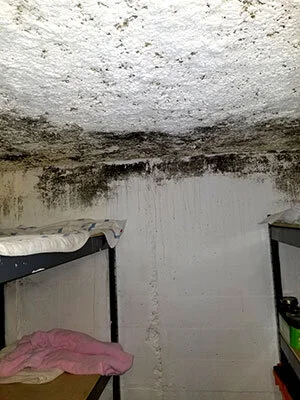What to do if you think you have mold in your home.
Have you ever had that moment of wow what is that smell? A musty odor seems to be in one particular room or portion of your house but where is it coming from? You mark it up to well maybe the window was left open or we’ve had a lot of rain lately that’s probably what I smell. Well that smell may be the start of something bigger. It is always a good practice to dig a little deeper if you smell or see mold. There are many homeowners that call us and say well I never go down there or I haven’t opened that closet in years. Those areas are great breeding grounds for the mold, dark cool spaces. The unfortunate thing with mold is insurance companies have very strict guidelines to not cover most mold claims. As homeowners we know the potential for an unseen leak is there with multiple water sources throughout our homes. One small pinhole or faulty drain can be the start of mold. We are in our homes 70% of our lives so its good to make sure that the air you are breathing is of good quality.
What is Mold?
Mold is a fungi that can grow on plants, wood, fabric, soil, food, drywall, floors and ceilings. Mold needs an organic material in order to grow accompanied by the right environmental conditions. There are many different types of mold that can occur inside and outside. Mold produces spores which are spread by floating in the air. Mold can affect the quality of air and structure in your home if not removed of properly.
Things to look for when determining if you have mold in your home.
Visually identifying mold
- Stains or speckled areas on walls, ceilings, floors, or furniture
- Water condensation or frost on inside walls
- Musty or earthy smell in the building
- Water leaks that cause water to pool on floors, drip from pipes, or stain surfaces like drywall or cement
- Mold that looks like it is spreading or comes back after cleaning
Symptoms of a mold allergy
If you are smelling or seeing possible mold accompanied by the below you may want to get someone into your home to take a look sooner than later.
- Sneezing and/or coughing
- Sore itchy throught
- Iritated itchy skin
- Red water eyes
- Difficulty breathing
What Causes Mold to Grow?
There are many areas that mold can grow with the right light and tempuratures. The mold needs a source to begin to form so any recent water damage or moisture could be the soucrce. If a wet area is not properly dried out it can cause mold to start growing within 24 hours.
Conditions that increase mold growth
- Water or excessive moisture speeds up mold growth
- Mold does not need sunlight to grow, only needs a spore and the right temperature.
- Damp dark spaces
Top 10 areas mold is found
- HVAC
- Duct Work
- Terminal Units
- Carpet
- Ceiling Tiles
- Cavity Walls
- Drywall
- Masonry Surfaces
- Attics
- Paper
How to remove mold
- Put on personal protective equipment (gloves, mask)
- Remove any wet or potetially wet items within 24 to 48 hours these items need to be taken out of the house.
- Air it out by opening doors and setting up fans
- Clean area with water and detergent - make sure to dry it right away
- Make sure all mold is gone and area is dry before painting or caulking
What to do if you are still not sure if you have mold in your home or if you want to tackle it yourself?
If you are still not sure if it is mold or if you don’t want to tackle it yourself you can reach out to a local mold remediation company. Sometimes it is possible to send photos to a mold specialist and they may be able to determine if it is mold or not. Most companies that offer this service will come to your residence as well to assess the area affected for a minimal fee. It is always a good idea to make sure any company you look for to do mold removal is certified with the IICRC.
If you would like more help with a current mold issue you are experience you can contact our office by phone #701-223-9249 or email us at admin@arrowserviceteam.com




